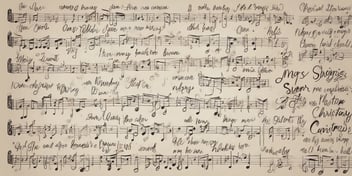- Blog
- Christmas song
- Dreaming of a White Christmas: An Analysis of the Beloved Song Lyrics

Ah, the quintessential Christmas jingle that never fails to put us in a festive mood - "White Christmas". Each year, as the winter winds blow and the holiday spirit fills the air, Bing Crosby's velvety voice serenades us with the timeless tale of longing for a snowy holiday season. But have you ever stopped to ponder the deep meaning behind those familiar lyrics? Join us as we embark on a whimsical journey through the iconic song, unraveling the magic and nostalgia hidden within its verses.
Prepare to dive into an analysis of "White Christmas" that will transport you to a world adorned with glistening icicles, delicate snowflakes, and the everlasting desire for a Christmas bathed in a scenic white wonderland.
Background and Significance of the Song
The song "White Christmas" holds immense cultural significance and has become synonymous with the holiday season. Written by Irving Berlin in 1942, it gained popularity during World War II and struck a chord with soldiers longing for home. Its timeless appeal lies in its ability to evoke nostalgia and a yearning for a traditional Christmas experience. The lyrics paint a vivid picture of a winter wonderland, showcasing the desire for snow-covered landscapes and cherished memories.
This song's enduring popularity and emotional resonance have made it a classic Christmas anthem cherished by generations.
Overview of the Lyrics
The lyrics of the beloved Christmas song, "White Christmas," convey a nostalgic longing for a traditional, snowy holiday season. As the song suggests, the image of a white Christmas holds immense sentimental value for many people, evoking memories of childhood and the joy of the holiday season. The lyrics paint a vivid picture of a winter wonderland adorned with glistening treetops and the sound of sleigh bells in the snow.
Through its simple yet evocative words, the song captures the essence of the holiday spirit and the desire for a picturesque Christmas experience.
The Concept of a White Christmas
Historical and Cultural Context
The historical and cultural context surrounding Christmas song lyrics like "White Christmas" provides valuable insights into the song's meaning. During the mid-20th century, when the song was first released, the concept of a "white Christmas" held a special significance. It represented an idealized vision of Christmas filled with snow-covered landscapes, cozy gatherings, and nostalgic memories.
This imagery resonated with people in regions where snowfall during the holiday season was common, evoking feelings of warmth and nostalgia. The cultural context surrounding the song reflects the enduring desire for traditional and sentimental Christmas experiences, which continue to influence the popularity and enduring appeal of "White Christmas."
Symbolism and Emotional Impact
Symbolism in the lyrics of "White Christmas" carries deep emotional impact. The mention of a "white Christmas" evokes feelings of nostalgia, purity, and joy associated with the holiday season. The white snow symbolizes a pristine, magical setting that brings back cherished memories and creates a sense of longing. The imagery of "treetops glistening" and "children listening" taps into the innocence and wonder of Christmas.
These symbolic elements resonate with listeners, transporting them to a world of happy recollections and a yearning for a picture-perfect holiday experience.
Analyzing the Lyrics
Verse by Verse Examination
In the first verse of "White Christmas," the line "I'm dreaming of a white Christmas" sets the tone of longing and nostalgia for a traditional snowy holiday. The second verse, "Just like the ones I used to know," emphasizes the desire for familiarity and recapturing past joy. The third verse evokes visuals of a picturesque scene with "treetops glistening" and "children listening," creating a sensory experience.
Finally, the fourth verse introduces the magical sound of "sleigh bells in the snow," further enhancing the festive atmosphere. Through these verses, the lyrics convey a yearning for a perfect Christmas setting and evoke sentimental emotions related to cherished memories of holiday celebrations.
Verse 1: I'm dreaming of a white Christmas
- In the first verse of "White Christmas," the longing for a white Christmas is expressed.
- The phrase "I'm dreaming of a white Christmas" encapsulates the desire for a traditional holiday experience.
- This verse sets the nostalgic and sentimental tone of the song.
- By highlighting the dreamlike quality of wanting a white Christmas, it taps into universal emotions and aspirations.
- The lyrics evoke feelings of warmth, coziness, and joyful anticipation associated with the holiday season.
- The imagery of a white Christmas resonates with listeners, regardless of their personal experiences with snow during the holidays.
- This verse also establishes the overarching theme of yearning for a simpler and idyllic time, which further enhances the emotional connection to the song.
Verse 2: Just like the ones I used to know
In the second verse of the beloved Christmas song "White Christmas," the lyrics "Just like the ones I used to know" evoke a sense of nostalgia and longing. This line captures the sentimental longing for past holiday memories and the desire to relive them. It resonates with listeners by tapping into the universal experience of reminiscing about happy moments from the past.
Whether it's recalling childhood festivities or cherished traditions, this verse connects on an emotional level, reminding us of the joy and warmth associated with the holiday season.
Verse 3: Where the treetops glisten and children listen
Verse 3 of the beloved Christmas song "White Christmas" paints a picturesque scene where the treetops glisten and children listen. This line captures the essence of a winter wonderland and evokes a sense of tranquility and joy. By mentioning the glistening treetops, the lyrics create a visual image of snow-covered trees, suggesting a serene and magical setting.
Additionally, the mention of children listening brings to mind the anticipation and excitement that comes with the holiday season. This verse serves as a reminder of the simple pleasures and innocence associated with Christmas, adding to the overall charm and appeal of the song.
Verse 4: To hear sleigh bells in the snow
Verse 4 of "White Christmas" evokes a sense of nostalgia and longing through its mention of sleigh bells in the snow. The imagery of hearing the bells creates a vivid sensory experience, transporting listeners to a winter wonderland. This line taps into the holiday spirit and the anticipation of joyful moments. For many, the sound of sleigh bells brings back memories of childhood and the excitement of Christmas traditions.
It serves as a reminder of the simple pleasures associated with the holiday season, adding to the overall charm and appeal of the song.
Repetition and Key Phrases
Repetition is a powerful tool used in "White Christmas" to create a sense of familiarity and emphasize the longing for a snow-filled holiday. The recurring phrase "I'm dreaming of a white Christmas" not only sets the theme but also reinforces the central desire for a picturesque winter scene.
Additionally, the line "just like the ones I used to know" evokes nostalgia and memories of past holidays, further enhancing the emotional connection. By employing these repetitive key phrases, the lyrics evoke a universal longing for a traditional and idyllic Christmas experience that resonates with listeners across generations.
Emotional Themes and Imagery
"Emotional Themes and Imagery" in "White Christmas" lyrics evoke nostalgia and a desire for traditional holiday experiences. Phrases like "treetops glisten" and "sleigh bells in the snow" create vivid imagery of a picturesque winter landscape. The song taps into sentimental feelings by emphasizing the importance of loved ones and cherished memories during Christmas. This appeals to the universal longing for a sense of warmth, togetherness, and joy during the holiday season.
The emotional depth of the lyrics resonates with listeners, reminding them of the essence of Christmas and the power of creating lasting traditions with family and friends.
The Legacy of 'White Christmas'
Impact on Popular Culture
In popular culture, the song "White Christmas" has had a profound impact. Its enduring popularity has led to numerous covers by various artists across different genres, making it a Christmas classic. The song's lyrics have been featured in countless movies, TV shows, and commercials, further solidifying its place in the cultural zeitgeist. Its message of longing for a nostalgic and snowy Christmas resonates with people worldwide, evoking feelings of warmth and holiday cheer.
The song has becomesynonymous with the holiday season and is often played during festive gatherings, creating a nostalgic and joyful atmosphere for all to enjoy.
Cultural Significance and Traditional Values
The lyrics of "White Christmas" hold cultural significance and reflect traditional values associated with the holiday season. The song portrays Christmas as a time for nostalgia, family togetherness, and the timeless appeal of a snowy landscape. It taps into the sentimental longing for a simpler time and resonates with people who value the warmth and joy that comes from celebrating with loved ones.
This cultural significance is evident in the enduring popularity of the song, as it continues to evoke emotions and create a shared experience across generations.
Key takeaways
The beloved holiday song "White Christmas" is analyzed in this article, exploring the deep significance and nostalgia associated with dreaming of snowfall during the Christmas season. The lyrics of the song, written by Irving Berlin, evoke a sense of longing for a traditional, picturesque Christmas, highlighting the cultural ideals and emotional attachments that surround the notion of a "white Christmas.
" The article provides a nuanced analysis of the song, delving into its historical context and examining how it has become a lasting symbol of holiday cheer and wistful aspirations.
Read On

Unraveling the Meaning Behind Bing Crosby's White Christmas Lyrics
Every holiday season, Bing Crosby's rendition of "White Christmas" fills the airwaves, immersing us...

Uncovering the True Meaning with White Christmas Lyrics
There's something undeniably magical about the holiday season when twinkling lights illuminate the...

Uncovering the True Meaning with White Christmas Lyrics
'Tis the season once again when Bing Crosby’s velvety voice takes center stage, crooning the...